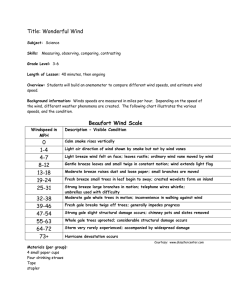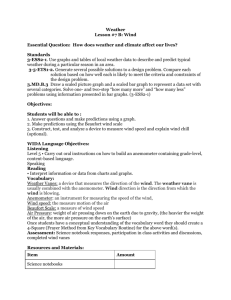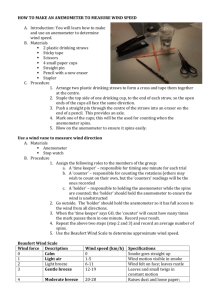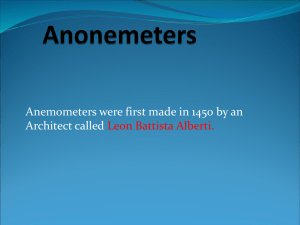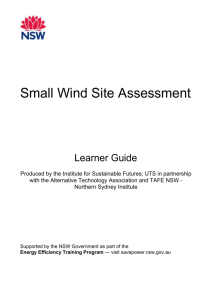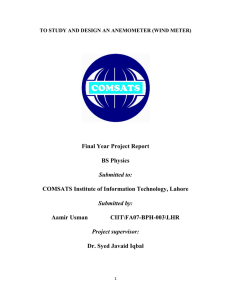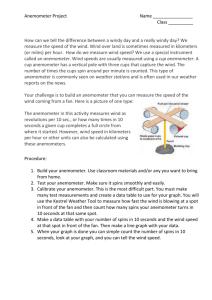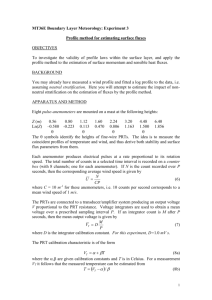Lesson #4: Wind Speed - Center for Learning in Action
advertisement
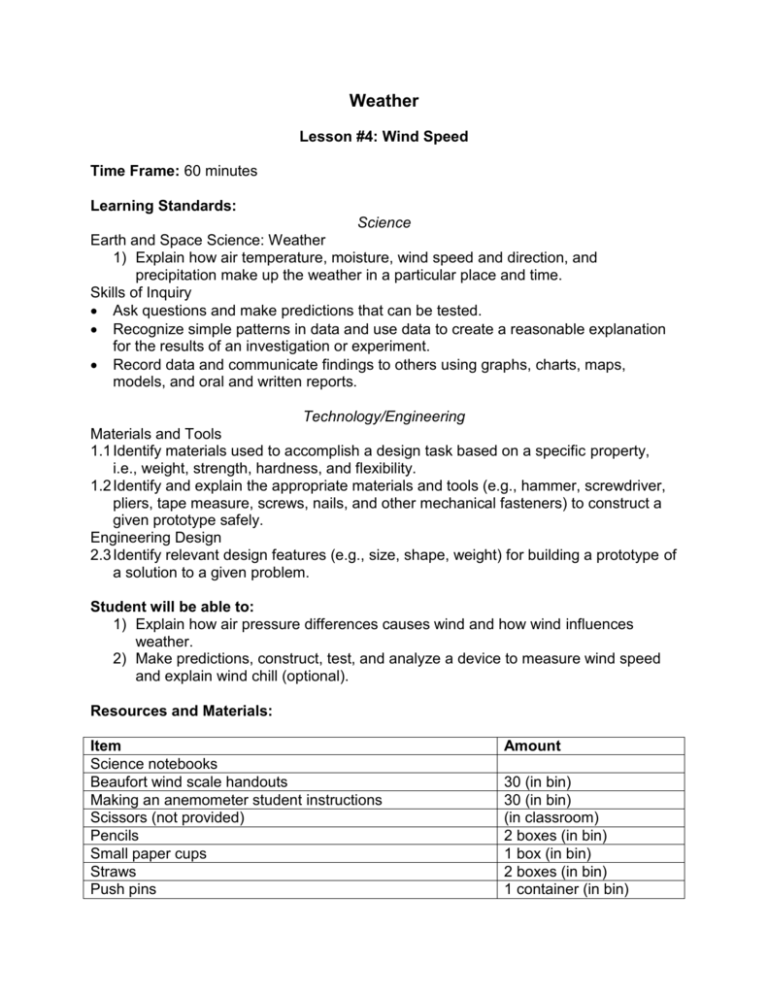
Weather Lesson #4: Wind Speed Time Frame: 60 minutes Learning Standards: Science Earth and Space Science: Weather 1) Explain how air temperature, moisture, wind speed and direction, and precipitation make up the weather in a particular place and time. Skills of Inquiry Ask questions and make predictions that can be tested. Recognize simple patterns in data and use data to create a reasonable explanation for the results of an investigation or experiment. Record data and communicate findings to others using graphs, charts, maps, models, and oral and written reports. Technology/Engineering Materials and Tools 1.1 Identify materials used to accomplish a design task based on a specific property, i.e., weight, strength, hardness, and flexibility. 1.2 Identify and explain the appropriate materials and tools (e.g., hammer, screwdriver, pliers, tape measure, screws, nails, and other mechanical fasteners) to construct a given prototype safely. Engineering Design 2.3 Identify relevant design features (e.g., size, shape, weight) for building a prototype of a solution to a given problem. Student will be able to: 1) Explain how air pressure differences causes wind and how wind influences weather. 2) Make predictions, construct, test, and analyze a device to measure wind speed and explain wind chill (optional). Resources and Materials: Item Science notebooks Beaufort wind scale handouts Making an anemometer student instructions Scissors (not provided) Pencils Small paper cups Straws Push pins Amount 30 (in bin) 30 (in bin) (in classroom) 2 boxes (in bin) 1 box (in bin) 2 boxes (in bin) 1 container (in bin) Large plastic cups Packing tape Stapler (not provided) Cardboard square Fan Anemometer Wind chill chart handout 1 bag (in bin) 1 (in bin) (in classroom) 24 (in bin) 1 (in bin) 1 (in bin) 30 (in bin) Focus Activity: Have students answer the following questions in their science notebooks. Does wind always travel at the same speed? What might make the wind blow harder? Will bigger differences in air pressure result in stronger or weaker wind? How might we be able to measure the speed of wind? Introduction: Review that wind is moving air in the atmosphere and happens because of differences in air temperature and air pressure. In the last class, students explored how to measure wind direction. Today they will explore how to measure wind speed. Introduce students to the Beaufort Wind Scale and explain that this is how winds with different speeds are described. Hand out copies of the class set of Beaufort Wind Scale student handouts. Discuss the differences between the different levels of wind. Explain that students can use these descriptions to assess the speed of the wind. Activity: 1) Explain that anemometers are tools used to measure the speed of the wind. Go over the procedure for making an anemometer. If the weather permits, tell students that they will test their anemometers outside when they are finished. Otherwise, use the fan provided to test the anemometers. a. Break the students up into small groups and provide them with the necessary handouts and materials. Assist student groups as necessary to construct and test the anemometer. b. When student groups are done making the anemometer go outside or use the fan to test the anemometers. Leave one or more anemometers outside and make observations over time. c. Assist the students in measuring and recording how many times their marked cup goes around in one minute. If using a fan, try to make this measurement with the fan at three different speeds. If outside on a windy day, make the measurements in 3 different locations. Use the anemometer provided to compare the results of the store-bought anemometer with the anemometers that the students made. d. Lead a class discussion of the results and ask the different students groups to share their observations and conclusions. 2) Wind Chill Extension activity: Discuss the concept of wind chill with the class. Explain that if it is cold and windy, the wind can make the temperature on your skin feel even colder. That is why there is no recess on cold days that are very windy. Pass out the Wind Chill chart to the class and discuss how to read the chart. Why is it important to consider wind chill when making weather forecasts? Closure: Discuss the following questions as a class. How can we measure wind speed? Why is it important to know about wind speed? How do strong winds affect humans? What makes wind stronger? Assessment: Science notebook responses, participation in class activities and discussions, completed anemometers Beaufort Wind Scale Observation Name of Wind Miles per Hour Smoke goes straight up Calm Less than 1 Smokes moves but wind vane does not Light air 1-3 Wind felt on face, leaves rustle, vanes begin to move Leaves and small twigs constantly moving, light flags extended Dust, leaves, and loose paper lifted, small tree branches move Small trees sway, small waves form on lakes Light breeze 4-7 Gentle breeze 8-12 Moderate breeze 13-18 Fresh breeze 19-24 Large tree branches move, wind howls around eaves Large trees sway, not easy to walk against the wind Twigs break off trees, hard to walk against the wind Branches break off trees, shingles are blown off Trees snap or uproot, building damage is possible Widespread damage to buildings Strong breeze 25-31 Moderate or near gale 32-38 Gale or fresh gale 39-46 Strong gale 47-54 Whole gale or storm 55-63 Violent storm 64-72 General destruction Hurricane 73 and over Making an Anemometer An anemometer measures wind speed (how hard the wind is blowing). Bigger differences between air pressures create stronger winds. Materials: Scissors Pencil 4 small paper cups 2 straws Push pin Large plastic cup Packing tape Stapler Cardboard square Directions: 1) Poke a hole through the bottom of the large cup (in the middle) so that the pencil can slide through. 2) Tape the cup to the cardboard and put the pencil through the hole (eraser side up). 3) Cut off the tops of the small paper cups so they are around 1 inch tall. Make a large mark on one of the cups. 4) Tape or staple a cup onto the end of each straw. Tape the cups so that they are facing opposite directions. 5) Staple the straws in an “X” shape and attach them to the pencil eraser with the push pin. 6) Test your anemometer. Observe your anemometer in several situations. Each time, record the number of times that the marked cup goes around in one minute in your science notebook. If the wind is stronger, the cup will go around more times.
